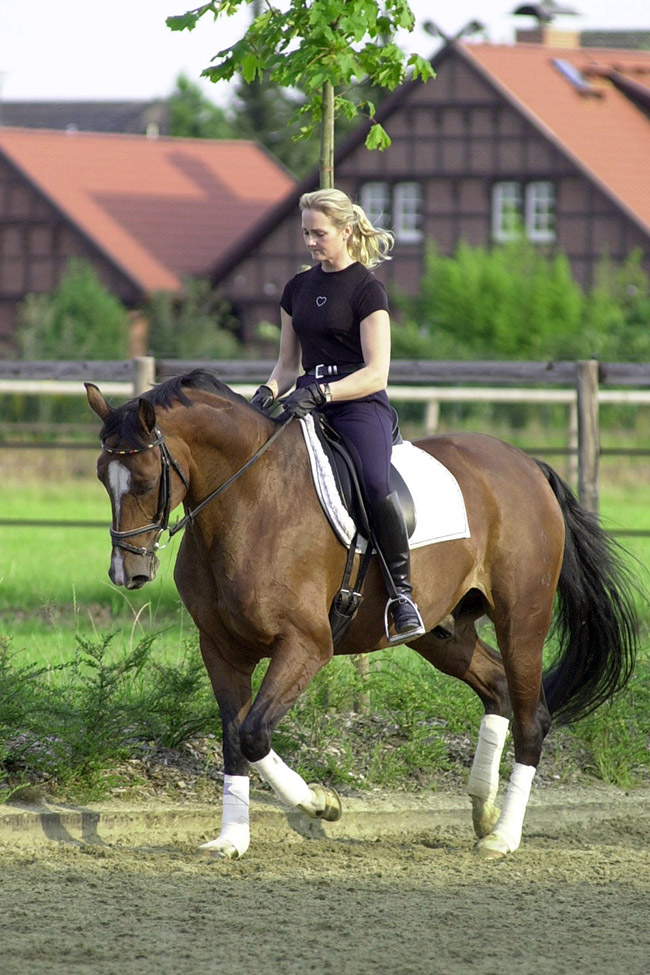 Words by Chris Hector and photos by Roz Neave
Words by Chris Hector and photos by Roz Neave
Poor Maree Tomkinson, you would have a thought a lesson with a top German professional rider-trainer-author-educator, would be a breeze. A wonderful opportunity to sit looking pretty on some superbly educated beastie with all his buttons firmly in place… but Susanne Miesner is too subtle for that. The Grand Prix option was too easy, a really uneducated youngster would take too long to see a result, so she hit on the perfect candidate – a very nice five year old Oldenburg gelding that belongs to a client and has not been ridden very well.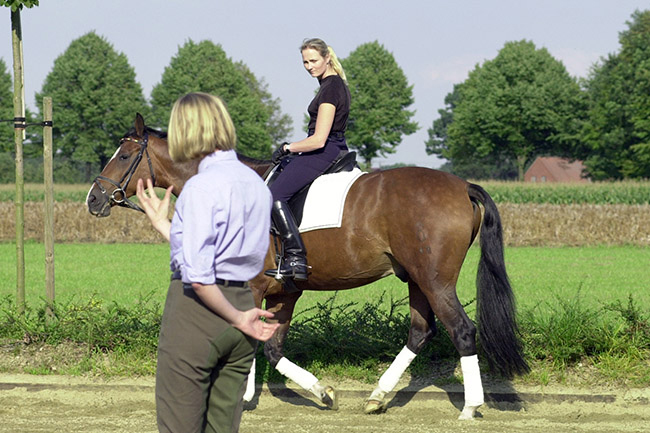
“You will find him tight in the back and difficult to get round” Susanne warned our girl as she led him out in the glorious late afternoon sunshine at the Miesners’ picturesque training centre at Milte, just ten minutes down the road from the famous town of Warendorf.
It was a judgement that Miss T heartily endorsed, ‘this horse is ignorant’ she hissed as she rode him round the outdoor school. Susanne was immediately in action, one of those wonderful instructors with an x-ray eye and a super turn of phrase:
“Start walking him on the buckle. This is so important at the beginning because it is only if the horse stretches his neck all the way, will his back muscles stretch and loosen. Lots of riders don’t emphasise this first walk enough, you need at least ten minutes. If you put the horse on the bit too soon he will stay round but you are not really working him because you can only really work a muscle when it contracts and then loosens.”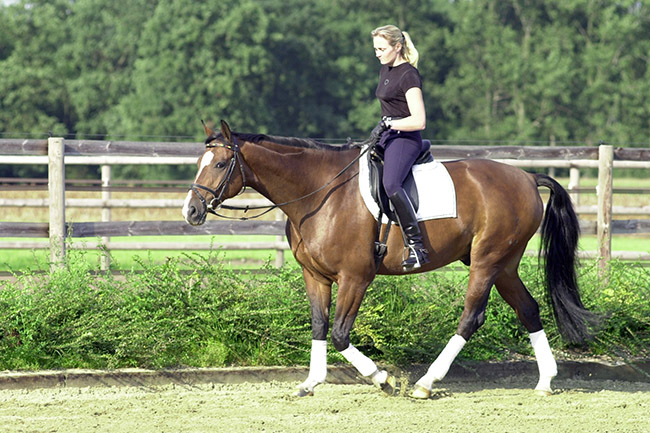
It must be confessed that the horse was walking in a most peculiar way and looking anything other than a dressage horse (‘this walk is weird’ says Ree as she shambles past us) but Susanne was working on the rider: “This walk is a nice time to do some corrections on your seat. Try to put your toes a little more parallel to the horse’s body so the side of your calf is soft to his belly, your toes are a bit too turned out. We used to think toes turned in was the way to ride but it is better if the leg just hangs naturally, breathing with the horse’s belly.”
“Now he is starting to walk over his back, make him more energetic with your voice, just cluck, try to get him a little more in front of your leg … that’s enough, there’s a limit, or you go over the rhythm.”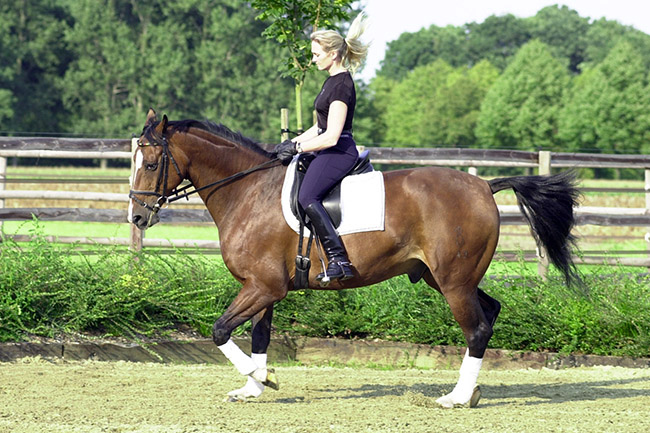
“Pick up the contact, drive with your lower leg. If you feel resistance, push more forward, shorten the reins and make him really take the contact. He’s testing you now to see how serious you are.”
“Now you see the problem, he wants to go hollow in the back and not stay in front of your aids. Before we start trot you have to somehow make him round.”
Maree agrees it is a problem: “He softens for a moment, then goes stiff.”
“That’s because his own rider hangs on to the rein for balance,” says Susanne, “he is not used to a rider like you who is in balance.”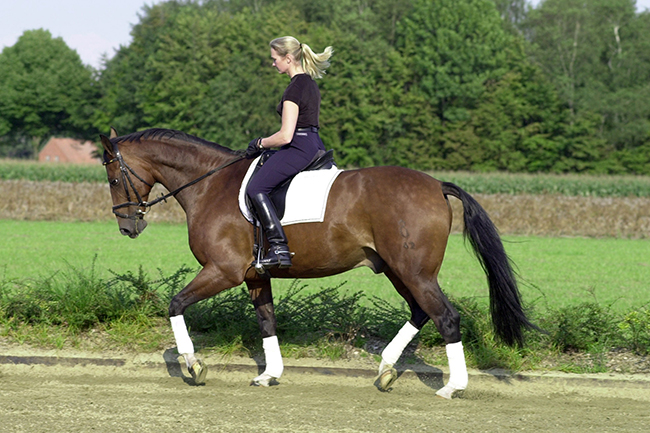
“Okay let’s try the trot.”
Again this is not a pretty picture, but Susanne is not going to give up: “Kick him with your lower leg, push him into a more forward working trot, and then back very slightly, forward and slightly back again. If you don’t get the horse in front of your leg, then you cannot influence his hindlegs – make him more forward, make him work from behind into the contact with the bit.”
“Continue to ride those transitions, so that the horse will listen to your driving aids and will loosen up his back, if the horse is blocking in the back, you will never get him through really.”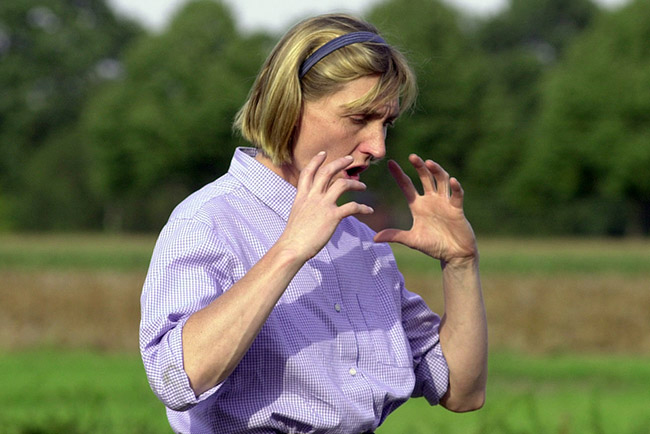
“Do you think he is better to the right?,” asks Maree. “He is hollow to the right,” agrees Susanne, “and tense to the left. Is hollow better than stiff? I’m not sure. The problem is that he is not listening to the forward aids, he doesn’t want to step forwards to the rein. He wants to step crooked, he wants to put his right hind foot to the outside, away from his body, and have his left hind between the two front legs, so he is pushing more with the right leg and carrying more weight with the left.”
By this stage, Susanne had decided that Maree could ride, and could use a whip, but a short whip.
“I think a shorter whip is much better to emphasise impulsion, and you can use a short whip on the shoulder. When you feel he is blocking, I don’t mind if you get a bit more forceful. Tap him on the shoulder so he knows you are the boss, now loosen him up again.”
“Ride posting trot, and remember the horse wants to lean on the left hand, and not take contact on the right.”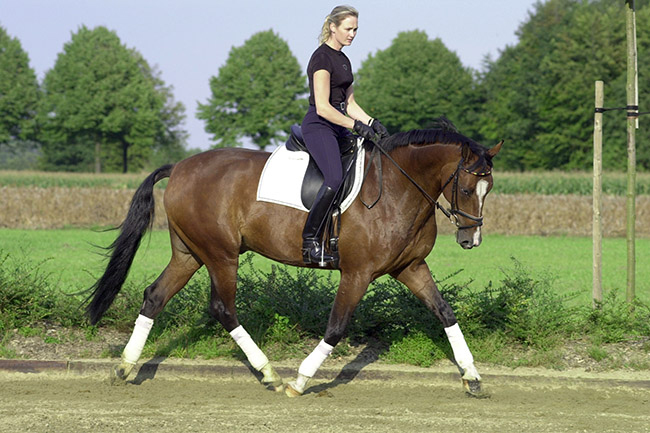
Suddenly we are seeing what a nice mover the gelding can be, as he takes a deep breath, decides to trust this new rider’s hand and swing along a bit. Susanne is delighted: “Now he is more forward, carrying his tail and so much round. Think of the child’s toy, the yo-yo, a few steps forward, a few steps shorter, when he drops his neck, pat him with your inside hand. In the moment you bring him back, push forward so the hind legs come under the balance point, you have to get that same wonderful feeling you get with a good jumping horse, that the wither comes forward. Keep the outside contact and slightly flex him to the inside.”
But just when you thought you had him, the darn animal would hollow up again.
Susanne was sympathetic to the horse: “The way this horse is ridden by his owner, you can’t expect him to work over his back for a whole half hour, you will just get a few moments like this … ”
“Now pick up canter. Canter is good to loosen the back of the horse. He has to canter forward, make it quicker from the ground so the legs are not staying too long in the air. Get after him, he has to stay in front of your leg. Don’t worry about connection, just forward – he might give you a buck every now and then because he is still tight in the back.”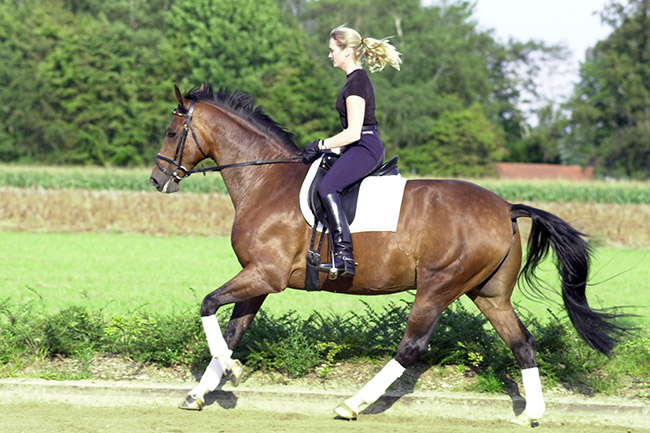
And sure enough he does, which doesn’t faze our girl in the least. “The tension in his back had to come out, either forward or a buck, that’s alright.”
“Don’t let him walk, don’t give him a break now, because that would seem to be a reward to him, and the work has not been good enough for a reward.”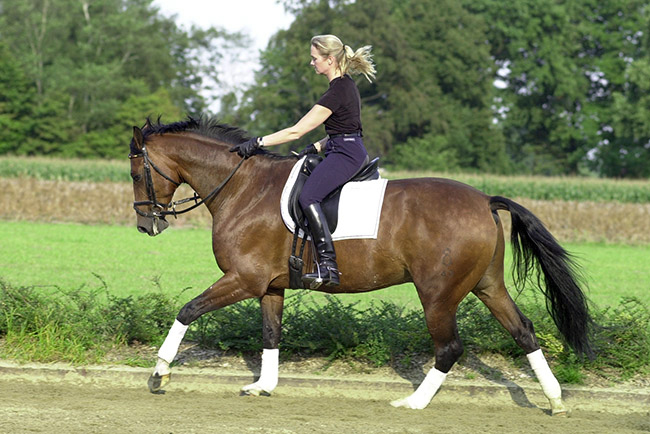
“Keep riding forward in the transition to trot, use little busy half halts to bring him more back, more on his haunches, stepping more under his balance, and before the transition to canter again, lower his neck, bring his wither up. He may be a little short in the neck right now, but when we are correcting a problem then we may overdo it for a little while – and then try to stretch a little.”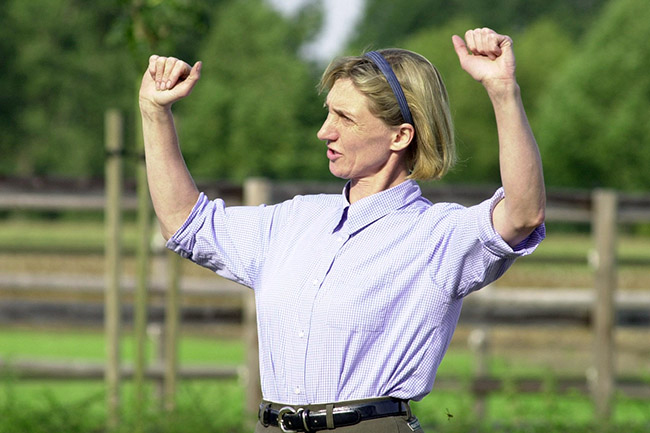
Stretch he does, and suddenly that ‘four cornered’ sweetly balanced trot appears.
“Yes,” says Susanne, “now this is a good looking horse. He starts to look pretty. That’s what I like about dressage, it’s like a happy person, they always look prettier. When the horse’s hind legs work better, it pushes the top muscles of the neck up and the horse looks prettier.”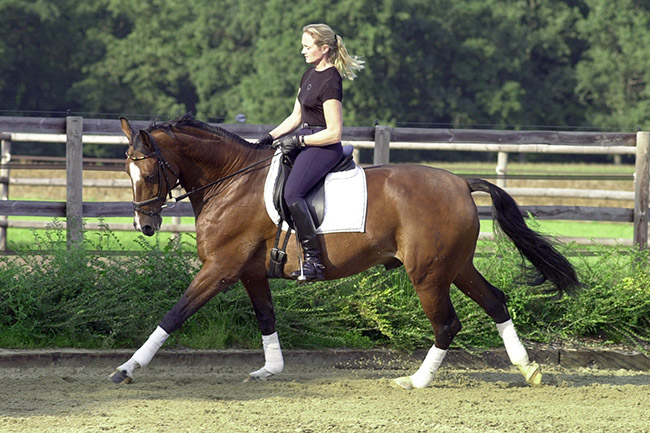
Once again, in canter, Maree was asked to ride the horse forward, then slightly back, but the main goal was forward and that goal was being admirably achieved by Maree. “I was a bit worried before the lesson,” Susanne says, “we get people from America and Australia, and they say they can ride … but Maree is an excellent rider.”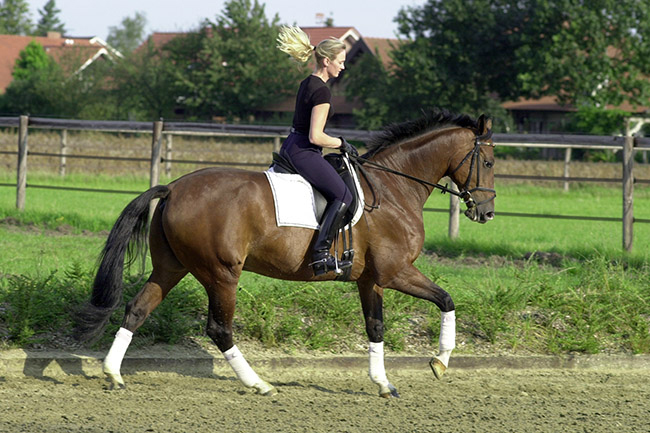
And really that is the end of the lesson, for the very good reason that until the horse is over the back there is no point in riding the tricks.
“This horse is not through enough to do any more than walk, trot and canter, to work on his back until he is supple. If Maree rode him for another week or two, then we could start doing some more interesting work. But he is starting to come round, so we will do a little more to reinforce the lesson.”
“I try to be kind to my horses, but it is the same with your kids, sometimes you have to say ‘no’. If he blocks in the back, kick him with your spurs, now trot on. Super! This time the horse waited for your aids.”
“Now we will do almost the opposite, I want you to ride him in a slower rhythm, so the horse starts to swing. Slow the speed to get a big over-track. And shorten the rein – Maree you always have the tendency to ride with a long rein – a long rein always has a tendency to pull, a short rein is more likely to be soft.”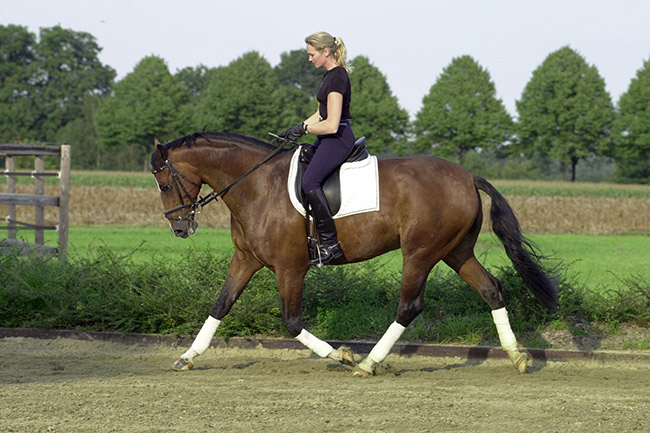
“Now he is on the bit, now he is using his back, now get him to stretch towards the bit. We don’t want him mechanically to keep his head in the one place – but it must always be with contact. If you feel him losing contact, push him forward.”
“But now he is a bit curled,” says Maree. “That’s right,” replies Susanne, “ride him forward again and put the contact on his mouth whether he likes it or not.”
“The horse should be going round and on the bit right from the start. The horse should be so comfortable with the rider that they fall into the rider’s hands without leaning on the bit. That is what we are aiming for, harmony between horse and rider, everything else is mechanical and not interesting for me. Only when the horse is through and accepting the contact, can he pick up the half halts by himself.”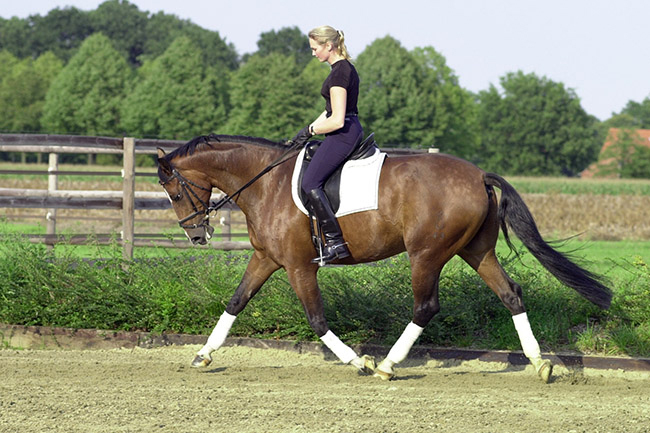
It’s a lovely concept isn’t it – the horse picks up the half halts by himself. Once again Susanne is happy to elaborate: “When we have a perfect connection from the hind legs over the back to the mouth, every time you push the horse’s hind legs, he gives himself a half halt. Everyone thinks the half halt is with the hand. In the Principles it says, a well trained horse should pick up the half halt by himself, if the rider gives the right aids. It’s a combination of seat, leg and rein, the half halt. A lot of people say ‘should I half halt on the left rein or the right rein’, the moment you say that, your body reacts like that, you think about the left or the right rein, and you forget the driving part of the half halt. The idea that the half halt is a combination of all aids, is something I emphasise in all my lessons.”
“This has been a good lesson for him, and now we can see the truth of the principle: when the tense horse becomes supple he is calm, when the lazy horse is supple, he goes forward.”
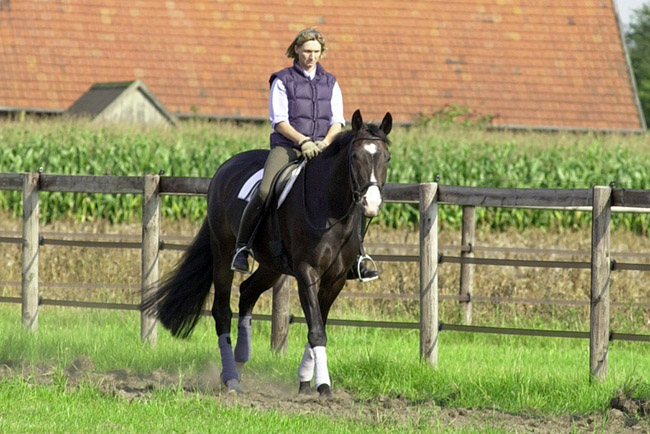 The Instructor: Susanne Miesner
The Instructor: Susanne Miesner
These days Susanne is only teaching ‘enough to be fun, but not so much that it wears you out’.
“For ten years I taught an awful lot in America. Now I teach about ten outside people who come to me each week, and I have about four or five students in my barn, and my kids, that’s enough.”
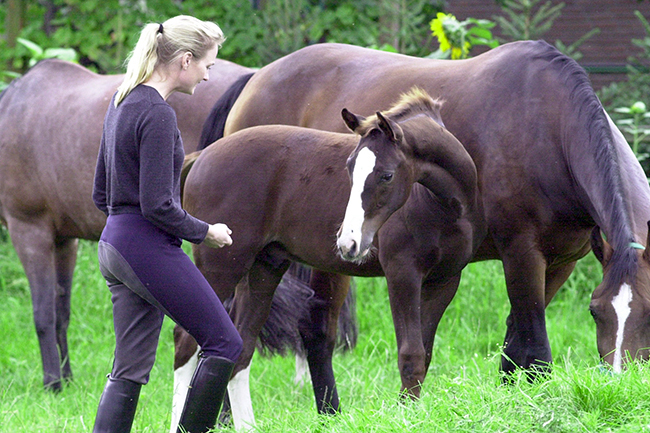 The pupil: Maree Tomkinson
The pupil: Maree Tomkinson
After dominating the showring for a decade, Maree Tomkinson has moved on to the next big challenge – dressage, and with it the possibility of international competition. In 2000, Maree made two trips to Germany, checking out horses, trainers, competitions – buying a foal (a colt by Rotspon – pictured) on her first trip, and on the second buying the licensed and performance tested stallion, Flambeau, and the young Weltmeyer son, Walton.
The Aim – Round & Over the Back
“The stage the horse is at, you couldn’t do anything else. If you don’t have the horse working in the back, you don’t have the horse working in the hindleg, and he is not good in the mouth. The scale of training is really true, you have to have rhythm and you have to have suppleness and everything else comes after that. The horse has a fair rhythm, but he wasn’t supple at all in the beginning. The main goal is to have a horse supple before he can do anything else. This horse is great because if he is ridden well he gives you a really good feeling, if Maree would ride the horse for two weeks you wouldn’t recognize him anymore.”
This article first appeared in the December 2000 issue of THM.
